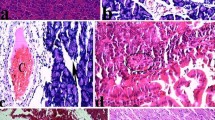Abstract
To define the role of free radicals and of lipid peroxide involvement during the progress of cerulein-induced acute pancreatitis in mice, we evaluated the effect of a novel free radical scavenger, 2-octadecylascorbic acid (CV-3611), on pancreatic edema formation, and the levels of serum enzymes (amylase, lipase) and of lipid peroxide in pancreatic tissue. Mice were divided into three groups: control group, intraperitoneal injection of saline only; pancreatitis group, cerulein 50 μg/kg injected intraperitoneally six times at 1-hr intervals; treatment group, CV-3611 10 mg/kg subcutaneously just after intraperitoneal cerulein injection. After the cerulein injection, the degree of pancreatic edema formation, serum amylase and lipase levels, and the amount of lipid peroxide in pancreatic tissue increased significantly during the observation period of 12 hr. Treatment with CV-3611 resulted in significant reduction in pancreatic edema formation at 3.5 hr (P<0.05) and 9 hr (P<0.05), serum amylase and lipase levels at 3.5 hr (P<0.05) and 12 hr (P<0.05), and lipid peroxide levels at 3.5 hr (P<0.05), 6 hr (P<0.05) and 12 hr (P<0.05). These results indicate that a novel free radical scavenger, CV-3611, has a strong therapeutic effect during the development of acute pancreatitis and suggest that oxygenderived free radicals play an important role in the pathogenesis of acute pancreatitis.
Similar content being viewed by others
References
Sanfey H, Bulkley GB, Cameron JL: The pathogenesis of acute pancreatitis. The source and role of oxygen-derived free radicals in three different experimental models. Ann Surg 201:633–639, 1985
Guice KS, Miller DE, Oldham KT, Townsend CM, Thompson JC: Superoxide dismutase and catalase: A possible role in established pancreatitis. Am J Surg 151:163–169, 1986
Fridovich I: The biology of oxygen radicals. Science 201:875–880, 1978
McCord JM: Oxygen-derived free radicals in post ischemic tissue injury. N Engl J Med 312:159–164, 1985
Nonaka A, Manabe T, Tamura K: Changes of xanthine oxidase, lipid peroxide and superoide dismutase in mouse acute pancreatitis. Digestion 43:41–46, 1989
Rutledge PL, Saluja AK, Powers RE, Steer ML: Role of oxygen-derived free radicals in diet-induced hemorrhagic pancreatitis in mice. Gastroenterology 93:41–47, 1987
Kato K, Terao S, Shimamato N, Hirata M: Studies on scavengers of active oxygen species. I. Synthesis and Biological activity of 2-O-alkylascorbic acids. J Med Chem 31:793–798, 1988
Terao S: A novel active oxygen species scavenger, CV-3611. Kyoto, The fourth biennial general meeting of the Society for Free Radical Research, 1988
Kuzuya T, Hoshida S, Nishida M, Kim Y, et al: Role of free radicals and neutrophils in canine myocardial reperfusion injury myocardial salvage by a novel free radical scavenger, 2-octadecylascorbic acid. Cardiovasc Res 23:323–330, 1989
Niederau C, Ferrell LD, Cirendell JH: Caerulein-induced acute necrotizing pancreatitis in mice: protective effects of proglumide, benzotript, and secretin. Gastroenterology 88:1192–1204, 1985
Kanazawa K, Minamoto S, Ashida HF: Determination of lipid peroxide contents in rat liver by a new coloration test. Agric Biol Chem 49:2799–2801, 1985
Minamoto S, Kanazawa K, Ashida H: The induction of lipid peroxidation in rat liver by oral intake of 9-oxononabic acid contained in autooxidized linoleic acid. Agric Biol Chem 49:2747–2751, 1985
Teshima S, Mitsuhida N, Ando M: Determination of α-amylase in biological fluids using a new substrate (β-2-chloro-4-nitrophenyl-mol to pentanoside). Clin Chim Acta 150:115–124, 1985
Kurooka S, Okamoto S, Hashimoto M: A novel and simple colorimetric assay for human serum lipase. J Biochem 81:361–369, 1977
Wisner J, Green D, Ferrell L, Renner I: Evidence for a role of oxygen derived free radicals in the pathogenesis of caerulein induced acute pancreatitis in rats. Gut 29:1516–1523, 1988
Boag JW: Oxygen diffusion and oxygen depletion problems in radiobiology. Curr Topics Rad Res Q 5:141–195, 1969
Barry H, John MCG: Review article: Oxygen toxicity, oxygen radicals, transition metals and disease. Biochem J 219:1–14, 1984
Freeman BA, Crapo JD: Biology of diseases: Free radicals and tissue injury. Lab Invest 47:412–426, 1982
Author information
Authors and Affiliations
Rights and permissions
About this article
Cite this article
Nonaka, A., Manabe, T., Kyogoku, T. et al. Evidence for a role of free radicals by synthesized scavenger, 2-octadecylascorbic acid, in cerulein-induced mouse acute pancreatitis. Digest Dis Sci 37, 274–279 (1992). https://doi.org/10.1007/BF01308183
Received:
Revised:
Accepted:
Issue Date:
DOI: https://doi.org/10.1007/BF01308183




